
International Research Journal of Engineering and Technology (IRJET) e-ISSN: 2395-0056
Volume: 12 Issue: 02 | Feb 2025 www.irjet.net p-ISSN: 2395-0072


International Research Journal of Engineering and Technology (IRJET) e-ISSN: 2395-0056
Volume: 12 Issue: 02 | Feb 2025 www.irjet.net p-ISSN: 2395-0072
Menbere Asmarea , Lakachew Abitew a , Birhanu Girmaa , Wu Zhigenqb*
aState Key Laboratory of Pollution Control and Resource Reuse, College of Environmental Science and Engineering, Tongji University, 200092, China
b*Shanghai Institute of Pollution Control and Ecological Security, 200092, China
Abstract – With an emphasis on condominiums in Bole Sub City, this study evaluated the production, disposal, and effects of domestic liquid waste (DLW) in Addis Ababa. The city's wastewater infrastructure was overburdened by the rapid urbanization and population increase; the Bulbula wastewater treatment facility was only using 23.67% of its 3,000 m³/day capacity. Only 24.8% of condominium homes had sewer connections, and every day, over 372.01 m³ of untreated or insufficiently treated DLW was released into the environment. Environmental testing showed that the Bulbula River's water quality has seriously deteriorated. Biological Oxygen Demand (BOD) values reached 90 mg/L, 50% above allowable limits, and ChemicalOxygenDemand(COD)levelsof 200–250 mg/L above WHO requirements by up to 53.3%. Some samples had an E. coli concentrationthatwasmorethan 12 times higher than what was considered tolerable, indicating serious contamination. Impacts on public health were noteworthy, with digestive and respiratory disorders being among the most common illnesses in the region. It was calculated that the annual cost of treating these illnesses was 6,973,750 ETB, or roughly 55,790 USD.Theresultsemphasized the critical need for community awareness campaigns, regulatory enforcement, and infrastructuralimprovementsto address DLW mismanagement and lessen its negative effects on the environment and human health.
Keywords: Domestic Liquid Waste (DLW), Wastewater Treatment,EnvironmentalImpact,PublicHealthRisks.
Global population increase and urbanisation are causing wastemanagementsystemstofacepreviouslyunheard-of difficulties,especiallyinemergingnations'cities.Domestic liquidwaste(DLW)isamajorproblemforcitiesaroundthe world.Alargeportionofthistrashisleftuntreated,which hasanegativeimpactontheenvironmentandhumanhealth [1].Thesituationisparticularlysevereinsub-SaharanAfrica sinceurbancentresgrowquickly,frequentlysurpassingthe construction of suitable wastewater infrastructure. The effectsofuntreatedliquidwasteonland,aquaticbodies,and airqualityareworsenedbyinadequatetreatmentfacilities andlegalframeworks[2].AddisAbaba,Ethiopia,isaprime exampleofthisdifficulty.Beingthecapitalandbiggestcityin
thenation,itsexpandingpopulationandurbanisationhave puttoomuchstrainonthewastewatersystem.Significant issueswiththeenvironmentandpublichealthhaveresulted from this, especially in places like the Bulbula Treatment Plant.Uncontrolledproductionandinappropriatedisposalof householdliquidwasteendangerecosystems,contaminate water supplies, and raise the incidence of waterborne illnesses in local populations [3, 4]. Urbanization and population growth have placed immense pressure on existingwastewaterinfrastructureinAddisAbaba,Ethiopia. BoleSub-CityCondominiumsgeneratesignificantdomestic liquid waste, approximately 372.01 m³ daily. Households eitherconnecttothecitysewersystemorusevehiclesfor onsite waste management. Condominium houses produce 50,715,335 liters of liquid waste daily (93.5 l/d/p). Only 24.8% of houses are sewer-connected, with 24,400 m³ of effluententeringtheKalitytreatmentplant[5]
Thishasledtotheuncheckedgenerationandimproper disposal of domestic liquid waste (DLW), posing a severe environmental and public health threat [6] Liquid waste generationinAddisAbabaisamajorconcernduetothelack ofproperinfrastructureandfacilitiesforwastemanagement [5].Thecity'slimitedseweragecoveragesystemisunableto copewiththeincreasingvolumeofliquidwastegenerated byhouseholds,industries,andcommercialestablishments. Asaresult,asignificantportionoftheliquidwasteendsup beingdischargedintoopendrains,rivers,andotherwater bodies,leadingtoenvironmentalpollutionandpublichealth risks [7]. The improper disposal of DLW has far-reaching environmental consequences (FAO, 2012). Contaminated wastewater infiltrates the soil, introducing harmful chemicals and pathogens that can contaminate crops and pose health risks to consumers. Additionally, untreated wastewaterenteringwaterbodiesleadstoeutrophication, anexcessivenutrientoverloadthatdepletesoxygenlevels, harmingaquaticlifeanddisruptingecosystems[8]
TheconsequencesofuncheckedDLWgenerationextend beyondenvironmentaldegradation,posingsignificantpublic healthrisks[9].Waterpollutionnotonlyharmshealthbut also increases medical costs, exacerbating urban poverty. Contaminatedwaterservesasabreedinggroundforharmful microorganisms,causingwaterbornediseaseslikediarrhea,

International Research Journal of Engineering and Technology (IRJET) e-ISSN: 2395-0056
Volume: 12 Issue: 02 | Feb 2025 www.irjet.net p-ISSN: 2395-0072
cholera, and typhoid outbreaks [10].These illnesses disproportionately impact vulnerable populations, particularly children and the elderly, causing substantial morbidity and mortality. Urban and peri-urban vegetable productioninEthiopiaisvitalforfoodsecurityandincome forpoorurbancommunities.However,limitedgovernment fundingandhouseholdhealthexpensesasuserfeeshinder accesstohealthcare[11]
The poor management and improper disposal of domestic liquid waste pose significant environmental and publichealthrisksinAddisAbaba,particularlyinBoleSub Citycondominiums,amidrapidurbanizationandinadequate wastewater infrastructure development[12]. This strain results in frequent overflows, leaks, and discharge of untreated or under treated wastewater into the environment,contaminatingvitalwatersources,including rivers and groundwater [13, 14] One of the primary challengesliesintheinadequateinfrastructureandservices for waste management, exacerbated by rapid population growthandurbanization.AshighlightedbyMekonnenand Argaw(2019)[15],Currentsewagesystemsandtreatment facilitiescannotcopewiththerisingliquidwastefromthe growingpopulation.Socio-economicissueslikepovertyand lack of awareness worsen improper disposal practices, increasingenvironmentalpollutionandpublichealthrisks [16]. The ways that domestic wastewater is collected, disposedof,andtreatedbeforebeingreleasedintonatural water sources determine how wastewater affects the environment. Because of their economic and ecological importance,authoritiesshouldincreasetheenergyefficiency oftreatmentplantsinordertolessenthiseffect[17]
Mismanagement of domestic liquid waste leads to environmentaldegradationbeyondwaterandairpollution, harming ecosystems. Eutrophication, caused by untreated wastewater entering water bodies, results from excessive nutrient overload [18]. This nutrient overload triggers excessivealgaegrowth,leadingtothedepletionofoxygenin thewater,harmingaquaticlifeanddisruptingthedelicate balanceofecosystems [19] Theintroductionofuntreated wastewater promotes invasive species, disrupting ecosystemsandcausingecologicalimbalances.
The economic losses associated with unchecked Domestic Liquid Waste (DLW) generation and improper disposal are substantial. Increased healthcare costs, and decreased property values are just a few of the economic repercussions [20] A crucial sector of Addis Ababa's economy is affected by perceived environmental degradationandhealthrisks,leadingtoincreasedhealthcare costsfromtreatingwaterbornediseaseslinkedtoDomestic Liquid Waste contamination [21]. Additionally, property values in areas affected by DLW pollution are likely to depreciate, impacting the overall economic well-being of communities.The main objective of this research is to improve environmental and public health in Addis Ababa,
Ethiopia, especially in Bole Sub-City condominiums, by examining urban domestic liquid waste challenges. It evaluatestheBulbulawastewatertreatmentplant'seffluent impactonBulbulaRiverasanindicatorofDLWeffectson health and the environment. By adjusting waste and environmentalmanagementprogramstousers'expectations and situations, the study's conclusions will enable policymakers, service providers, waste planners, and environmental authorities to improve efficient waste managementmethods[22]
2.1.
Asshownin(Fig.1),AddisAbabaislocatedincentral Ethiopia at 80 45’ to 9° 5'38.48"N north latitude and 380 34’’to390 4’eastlongitude ItisthebiggestcityinEthiopia withapopulationof5.7millionasof2024[23].AddisAbaba wasestablished139yearsagoandhassinceexpandedintoa 546km²,heavilypopulatedmetropolisencircledbyvolcanic highlands.Withitssteepslopesandrapids,theEntotoRidge in the north creates a watershed boundary between the AwashandBlueNilebasins.From3003metersatEntototo 2000metersatAkaki,thewaterflowsfromnorthtosouth
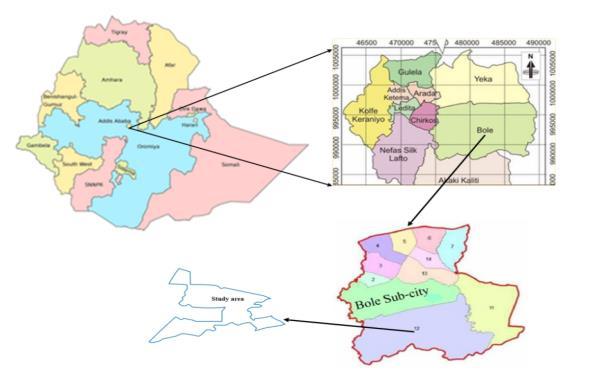
2.2.
Theresearchappliedacross-sectionalstudydesignto assessthecurrentstateofdomesticliquidwastegeneration, disposal and treatment in Bole Sub city Condominiums as shownin(Fig.3).Thisdesignallowedthecollectionofdata from the Addis Ababa water and sewer authority, Environmentalprotectionauthorityandlaboratorytesting oftreatedeffluent.

International Research Journal of Engineering and Technology (IRJET) e-ISSN: 2395-0056
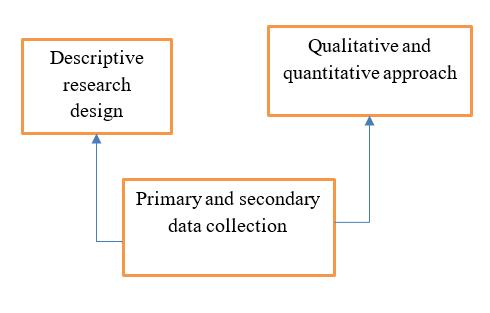
4: Graphical representation of Research Design and Methodology
2.3. Data Collection Methods
Both primary and secondary data were used in the investigation.TheAddisAbabaWaterandSewerAuthority contributed secondary data on wastewater treatment and infrastructure, and the local government supplied information on housing and population. The analysis was supplemented by laboratory tests and health effect data from Bulbula Health Centre. A lab test was conducted to check the pollutant level of the wastewater and the river water itself [24, 25]. The turbidity, pH, conductivity, BOD, COD,TDS,andcoliformcountofwatersamplesweretested attheAddisAbabaEnvironmentalProtectionAuthorityand WaterandSewerAuthoritylaboratories.Thetestsaimedto evaluate whether the treatment plant's effluent adversely affectstheriver,comparing resultsto WHO guidelinesfor naturalsurfacewatertoprotectaquaticlife.
3. Results and Analysis
The findings from the study reveal several key insights regarding domestic wastewater generation patterns and practices, its impact on the environment and people. The findingsoftheresearcharegivenasfollows.
3.1. Domestic liquid waste generation
3.1.1. Existing Treatment plants in Addis Ababa
According to the Addis Ababa Water and Sewer Authority2023[26]annualreportthereareabout43(22 Ananaerobic baffled reactor(ABR), 5WasteStabilization Ponds (WSPs) and dry bed , 12 Membrane Bioreactor (MBR),2Upflowanaerobicsludgeblanketreactor(UASB)r +trickling filter (TF), 1 Wetland and1 CAS (conventional Activated sludge),wastewater treatment plants in Addis Ababaundertheauspicesoftheauthority.Amongthese3 arecurrentlynotfunctionalandabout8arestandbyand2 dry bed plants for vacuum truck carry and dump system. Theremaining30plantsarefunctionalwithdesigncapacity offiltering197,047m3/day.Thecurrentactualcapacityof
treatmentis121,050m3/dayAddisAbabaWaterAouthority (AAWA2023),asshownin(Fig.5).
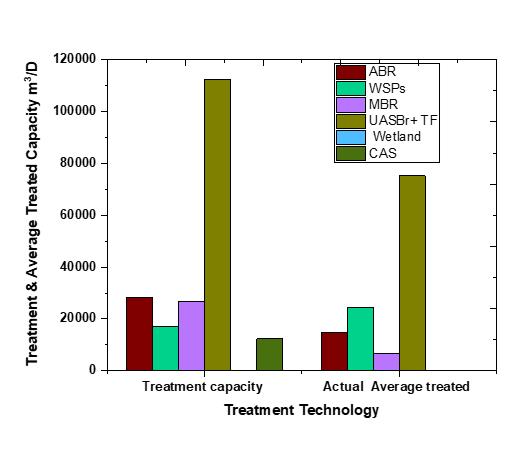
Fig.6:LiquidwastetreatmentplantsrunbyAAWSAin AddisAbaba(26)
Due to low flow and maintenance problems, the Membrane Bioreactor (MBR) plant in the Bulbula condominiumneighborhoodonlyfunctionsat710m³/day, or23.67%ofitscapacity.TheMBRplantwassupposedto operate at 3,000 m³/day. With the maximum capacity of 197,047m³/dayandanaveragetreatedvolumeof121,050 m³/day,AddisAbabaWaterandSwerAouthority(AAWSA's) treatment plants are highlighted in a graph. Significant underuse is evident in some plants, such as one with a capacity of 28,320 m³/day, which barely treats 14,600 m³/day. This provides information on the effectiveness of the city's wastewater management system by reflecting differencesinfacilitysizeandperformance.Thetreatment plantislocatedatthesoutherntipofthecondominiumsite atabsolutelocationof38.7874730Eand8.94349830E.
3.2.
The Bulbula condominium site is located in Addis Ababa, Bole-sub-city between 38.784140 and 38.7968650 Eastandbetween8.9435460 and8.9543340 Northwiththe total area of 39.1 ha. The site consists of 175 blocks and 4,481occupiedhousingunits.TheAddisAbabaWaterand SwerAouthority(AAWSA)monthlyliquidwasteproduction of 11,160.33 m³, averaging 372.01 m³ daily. With a populationof20,165residents,thisresultsina percapita wastewaterproductionof16.34litersperpersonperday, whichislowerthantheSub-SaharanAfricaaverageof30.36 liters [27]. Bulbula Condominium faces water shortages, withsupplyavailableonlythreedaysaweekfor12hours. Limitedrooftopreservoirsforcehouseholdstostorewater in barrels and flush toilets manually. The sewer network, consistingof110mmPVCpipes,collectswastewatertothe
Volume: 12 Issue: 02 | Feb 2025 www.irjet.net p-ISSN: 2395-0072 © 2025, IRJET | Impact Factor value: 8.315 | ISO 9001:2008

International Research Journal of Engineering and Technology (IRJET) e-ISSN: 2395-0056
Volume: 12 Issue: 02 | Feb 2025 www.irjet.net p-ISSN: 2395-0072
treatmentplant.Blockagesatmanholesrequirebi-monthly drainage services. The treatment plant operates at just 23.67%capacity,handling372.11m³/day.
The research examined the environmental effects of wastewater from the Bulbula site on the Bulbula River. Effluent from the treatment plant was analyzed, with samples collected from three locations, including one (SampleA)takenbeforemixingwiththeriver.Theabsolute location of point A is 38.787843°E and 8.940735°N. The secondsample(SampleB)wascollectedfromtheBulbula River, approximately 1 km upstream of the effluent discharge,indicatingtheriver'sconditionbeforethetreated effluent mixes in. The absolute location of point B is 38.799857°Eand8.946117°N.Thethirdsample(SampleC) wascollectedabout1kmdownstreamaftertheriverandthe treated water has been thoroughly mixed. The absolute locationofpointCwas38.781919°Eand8.936810°N.This partisexpectedtoindicatetheimpactofthetreatedwater onthewaterqualityoftheriver.
The pH value of water is closely related to its concentrations of carbon dioxide (CO2) and alkaline substances [28]. In this study, pH values were alkaline, ranging from 7.99 to 8.03, with no significant difference between treated effluent and river water, as shown in (Fig.7).This indicates low CO2 levels, which generally reducepH.ResearchonpH'seffectsonfoodandwaterborne pathogens is increasingly prevalent in laboratory and uncontrolled settings [29] The pH of pharmaceutical wastewaterfromvariousbatchprocessescansignificantly vary, ranging from very acidic to alkaline, often due to detergentresidueslikesodium-basedsoapspresentinthe treatedwater[30] Theriverwater'spHexceedsthatofthe treatedeffluent,potentiallyinfluencedbyadditionaleffluent fromtheBoleLemiindustrialpark,located8kmupstream. Furtherresearchisnecessarytoevaluatetheimpactofthis industrialdischarge.
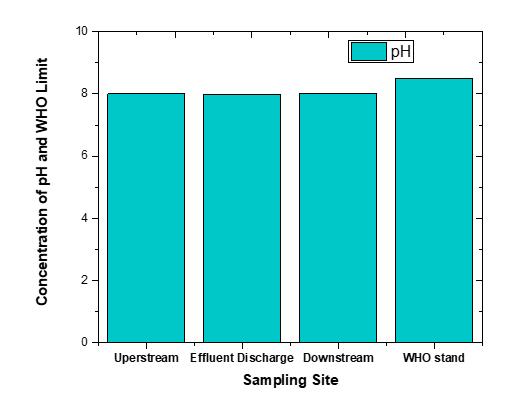
Asshownin(Fig.9)Turbiditymeasureswaterclarity; higherturbidityindicatescloudierwater.Variousmaterials causeturbidity,includingsilt,organicandinorganicmatter, clay,algae,andmicroscopic organisms.The turbiditytest resultindicatesthatitrangesfrom<20to142NTU(figure 2).Turbiditycanhindersunlightpenetrationtothewater's surface, limiting photosynthesis in aquatic plants and potentiallycausingcascadingeffectsthroughouttheentire ecosystem [31] High turbidity can impair the vision and breathingoffishandotheraquaticorganisms,asitmayclog their gills, making respiration difficult [32]. Turbid water absorbs more sunlight, leading to increased water temperatures.Thiscanstressaquaticorganismsandreduce their oxygen levels [33]. Water turbidity influences pollution levels in rivers. Our tests showed that the least turbidwateroriginatedfromthetreatmentplantdischarge, demonstrating its effectiveness in eliminating suspended solidsthatcontributetoturbidity.
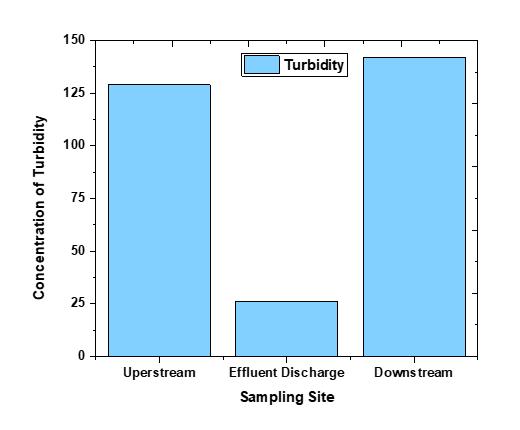
Conductivityindicateswater'selectricalconductivity; higher dissolved salts and inorganic chemicals increase salinity, reflecting a greater concentration of dissolved substances [34] Water conductivity can be affected by mineralsinthewaterbed,agriculturalrunoff,urbanrunoff, and industrial effluent.As shown in (Fig.11), the highest conductivity recorded was 1075 µs/cm in the effluent discharge, while samples B and C had values around 450 and 510 µs/cm. Notably, the effluent's conductivity exceededbothupstreamanddownstreammeasurements. Themixingofthehighlyconductiveeffluentwithupstream water led to a lower downstream conductivity of 510 µs/cm,likelyduetodilutionfromadditionaldischargesor mineral-absorbingalgaereducing mineral levelsbetween pointsAandC.

International Research Journal of Engineering and Technology (IRJET) e-ISSN: 2395-0056
Volume: 12 Issue: 02 | Feb 2025 www.irjet.net p-ISSN: 2395-0072
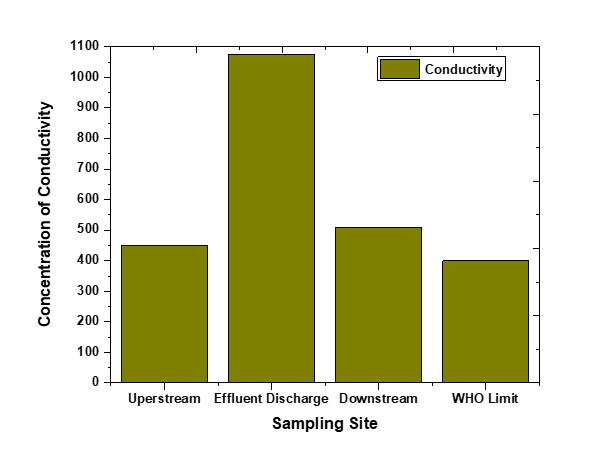
ChemicalOxygenDemand(COD)measurestheoxygen needed to oxidize organic matter in (Fig.13), Water indicatingtotal organicpollution.HighCODlevels suggest significant pollution, depleting dissolved oxygen and harmingaquaticlife,particularlyfishandorganismsreliant onoxygenforsurvival[35,36] Highorganicmatterlevels can lead to eutrophication, causing excessive nutrient buildupinwater thattriggersalgal blooms.These blooms deplete oxygen, resulting in fish deaths and making the waterunpleasantforuse[37]. ThetestresultsofCODlevels vary according to test results. The Water and Sewer Authority's findings confirmed low treatment efficiency, whereas the Environmental Protection Authority found increased COD from samples A to C. Significant contaminationwasindicatedbysamplesA,B,andC,allof which recorded 200 mg/l, 250 mg/l, and 230 mg/l, respectively,abovetheWHO's150mg/lstandard.
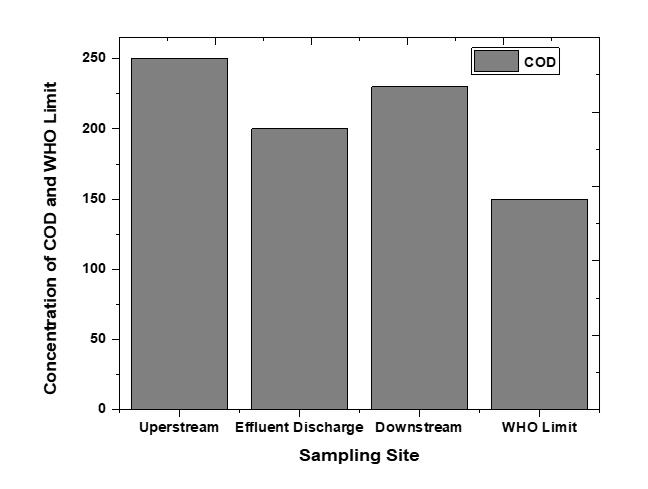
As shown in (Fig.15), BOD measures the oxygen requiredbymicroorganismstobreakdownorganicmatter in water, indicating pollution levels. High BOD suggests significantorganicwaste,depletingoxygen,whilelowBOD indicatesbetterwaterquality[38-40].BODlevelsarehighest in upstream and downstream samples and lowest at the dischargesite.SampleArecorded85mg/l,whileSamplesB and C reached 90 mg/l. These results indicate significant contaminationfromuntreatedsewageorindustrialwaste, necessitatingquickaction.TheWHOstandardis60mg/l.
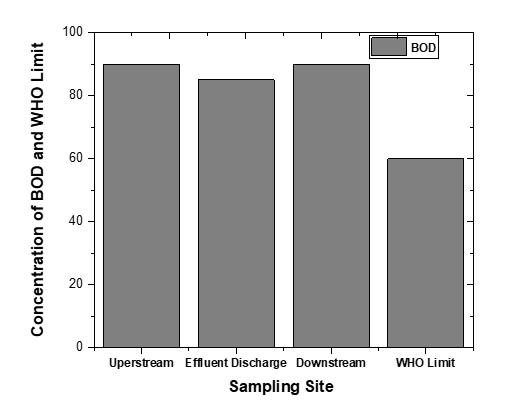
E.coliisabacteriacommonlyfoundintheintestinesof warm-blooded animals, including humans (Fig.17). While manystrainsareharmless,somecancauseseriousillnesses. The presence of fecal coliform bacteria in water indicates contamination from warm-blooded animal feces[41]. This means that the water has likely been contaminated with humanoranimalwaste.Fecalcontaminationcanintroducea varietyofharmfulpathogensintothewater,including[42]. Becauseofdilution,E.colilevelsaremoderatedownstream, lowest at the effluent discharge, and highest upstream. Sample A recorded 180 MPN/100 ml, Sample B 1600 MPN/100 ml, and Sample C 920 MPN/100 ml, above the WHO limit of 126 MPN/100 ml. Every sample has levels above safe limits, necessitating prompt source protection andremediationactions.

International Research Journal of Engineering and Technology (IRJET) e-ISSN: 2395-0056
Volume: 12 Issue: 02 | Feb 2025 www.irjet.net p-ISSN: 2395-0072
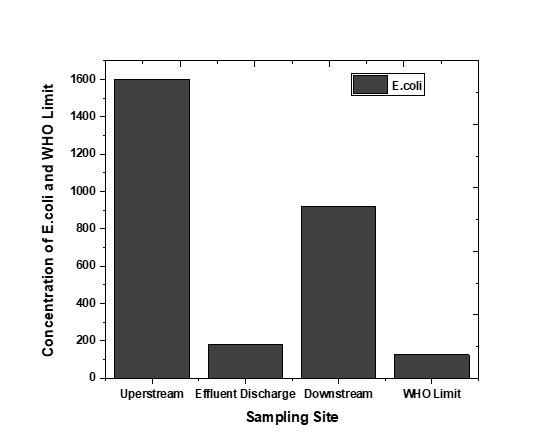
Total dissolvedsolids,orTDS,area measureofthesalts andmineralsinwater.Toevaluatetheeffectsofhumansand theenvironmentonwaterquality,itisessentialtomonitor TDSandotherindicators[43],asshownin(Fig.19).Aquatic ecosystemsandwastewatertreatmentareimpactedbyhigh TDS levels. The effluent from the treatment plant exhibits excessive TDS, which could be the result of an ineffective membrane that is eight years old or increased use of householdproducts.ElevatedTDSendangersaquaticlifeand disturbs ecosystems by stressing freshwater species, encouragingalgaeblooms,andreducingoxygenlevels.For mitigation,properupkeepandmonitoringareessential.
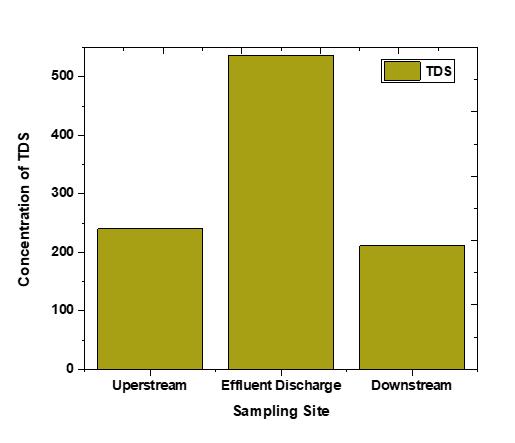
3.3.1. Variations of microbiological parameters of sampling sites
Thestudyevaluateseffluentanddownstreamwaterquality toassessenvironmentalimpact,usingWHOstandardsasa control. A one-tailed paired t-test showed treated water qualitybelow WHOstandardsfor natural water,witha pvalueof0.099789,supportingthehypothesis.Thisindicates
the effluent does not meet WHO minimum requirements. Thetestalsocomparesupstream(natural)anddownstream (contaminated)waterqualityparameters,highlightingthe effluent’s effect on water quality. Results are shown in (Fig.21). If no difference exists, the treatment plant effectively treats waste without environmental impact. However,asignificantdifferenceindicateseffluentdischarge is degrading river water quality, highlighting the plant’s impact on the environment. Accordingly the p value obtainedona1tailpairedt-testwas0.325and2tailt-test was0.65whichisgreaterthantheconventional0.05(95%) confidenceinterval.Thisindicatesthatthereisnosignificant differencebetweentheupstreamwaterandthedownstream water.Howeverthetestresultsoftheeffluentdischargesat A,theupstreamatBandthedownstreamatCallhavenot fulfilledtheWHOstandardfornaturalsurfacewater. Test results confirm that Bulbula River water is already contaminated,evidentbythelackofaquaticlife.Sincethe river is polluted before reaching the Bulbula wastewater treatmentplant,theplant'sdischargedoesnotaffectwater quality.AtreatmentplantatBoleLemiIndustrialPark,8km upstream,mayinfluencerivercontamination.Publicconcern ishigh,with61%worriedaboutwatercontaminationand 68%reportingunpleasantodors.
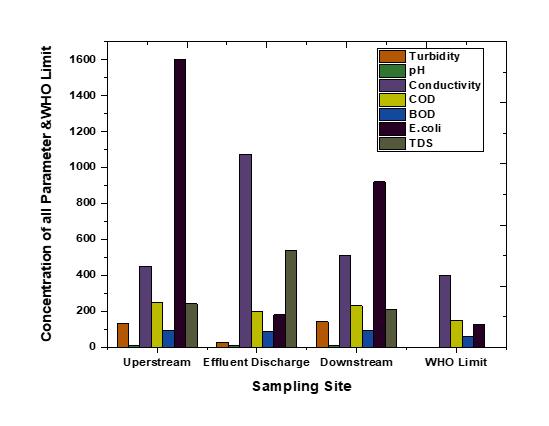
3.4. Comparision of Organic Pollution Indicators
Research on Addis Ababa's water quality reveals significantvariationsinparameterslikepH,turbidity,E.coli, TDS,COD,BOD,andelectricalconductivityduetodiffering samplesites,environmentalsources,andhumaninfluences asshownin(Table.1).In2022,SolomonTibebureportedpH levels of 6.7–8.1, moderate BOD (51 mg/L), and COD (68 mg/L),indicatingorganicpollution.Turbidityreached850 NTU, reflecting substantial sedimentation. E. coli

International Research Journal of Engineering and Technology (IRJET) e-ISSN: 2395-0056
Volume: 12 Issue: 02 | Feb 2025 www.irjet.net p-ISSN: 2395-0072
concentrationswereconcerningat737CFU/100mL,likely duetountreatedsewageorrunoff[6].
In contrast, this study revealed alarming pollution levels, with BOD ranging from 85 to 90 mg/L and COD peaking at 250 mg/L. Turbidity reached as high as 1600 NTU, indicating severe particulate matter contamination fromurbanrunoff.E.colilevelswerealsoelevatedat129 CFU/100mL,alongside electrical conductivity readings of 450to1075µS/cm,posingseriouspublichealthrisks.Other studies, such as those by Gizaw Ebissa (2024)[44] noted varying COD and turbidity levels that still indicated significant pollution challenges requiring urgent intervention. Similarly, Terusaw Solomon (2024) [45], reported elevated COD levels of up to 418 mg/L and turbidity reaching 228 NTU, indicating significant water quality concerns despite being lower than this study findings.
As opposed to, Thandile T. Gule (2023) [46], found relatively low turbidity and salinity values, indicating less pollutedwatersources,althoughthestudy'slimitedscope reduced its comprehensiveness compared to others. High organicpollutionandturbiditywereconsistentissues,with this study findings showing the contamination. Elevated COD, turbidity, and E. coli levels highlight wastewater treatmentchallenges.NotableECvariationsindicatesalinity differences, emphasizing the need for integrated water management and pollution control. These findings underscoretheneedforintegratedwatermanagementand pollution control to ensure safe water for the growing population.

International Research Journal of Engineering and Technology (IRJET) e-ISSN: 2395-0056
Volume: 12 Issue: 02 | Feb 2025 www.irjet.net p-ISSN: 2395-0072
Asshownin(Fig.23),improperliquidwastehandling and disposal negatively affect residents' health in several ways. It can lead to air quality deterioration, causing respiratory diseases, and create breeding grounds for insects,impactingsurfacewaterquality.AtBulbulaHealth Center,respiratorytractdiseasesranked6th,andintestinal diseases5thamongthetop10commonillnesses,suggesting a link to improper waste management. Actual disease incidencemaybehigher,ashealthcentersareoftenthefirst pointofcontactformedicalcareinEthiopia.
However, many individuals may choose to visit hospitals instead,anticipatingbetterqualitycaredespitethehigher costs associated with hospital visits [47]. This trend is particularly evident in urban areas, where wealthier householdsand urbanresidentsaremorelikely to utilize hospitalservicescomparedtothoseinruralsettings([47], [48]).
The preference for hospital care over local health centers can exacerbate health disparities, particularly in low-incomecommunitieswhereaccesstoqualityhealthcare is limited ([47, 48]). Moreover, the underutilization of health centers can lead to an underreporting of health issuesrelatedtowastemanagement,asindividualsmaynot seekcareformildsymptomsormayattributetheirhealth problems to other causes[49]). This situation is compoundedbythefactthathealthcentersoftenthelackof resources and infrastructure in health centers often discourages residents from seeking treatment for health issuescausedbypoorwastemanagementpractices([50]).
Theimplicationsofthesefindingsunderscoretheneed for improved waste management strategies and public healtheducationtoaddressthehealthrisksassociatedwith improperliquidwastehandlinginthecommunity[51].

(AToUns),Acute tonsillitis (ATo), Dyspepsia, General adult medical examination (GAME), Bacterial intestinal infections, unspecified (BIUN),Acute nasopharyngitis (Anaso),Essential hypertension (Ehyp),Cough, Examination for driving license (ExaDL),Urinary tract infection, site not specified (UTI))
According to the Bulbula health center annual report treatmentofintestinalinfection(the5th top10)wouldcost about200ETBor1.66$ forlabtestandmedicine,howeverit takesabout7daystocompletetreatmentduringwhichthe patientwouldbeoffwork.Theminimumpaiddailycasual worker earns about 150ETB or 1.25$ per day and loses about150*7=1050ETBor8.75$inaweekduringhissick period.Asaresulttheeconomiclossofapersonsuffering fromintestinaldiseasewouldlose200+1050=1250ETBor 10.4$apartfrommorbidity,physiological,andpsychological discomfort.Asdepictedonfigure14abovethetotalcasesof intestinalinfectioninayearwas3147persons.Whenthis multiplied by the per capita treatment related expense of 1250Birror104$equals3,933,750Birror32781.2$. Acute naso-pharyngitis, the 6th most common disease likely caused by odor and air pollution from wastewater mismanagement, affects 3,040 patients. Treatment costs about250ETB($2.08),andpatientslose5workdays,which onthebasisofadailylabourerincomeamountto5days * 150ETBor1.25$costing750ETB($6.25).Thetotalcostof thenaso-pharyngitistreatmentandoffworkcompensation equals 1000ETB or 8.33$. When this multiplied by the number of patients (3040) equals 3,040,000 ETB or 25333.3$.Theeconomiclossfromthewaterandairborne diseaseasaresultofwastewatermismanagementwouldbe 6,973,750ETBwhichisapproximately55,790USD.
Targeted initiatives are essential to tackle the environmental and public health challenges posed by domestic liquid waste (DLW) in Addis Ababa, particularly withintheBoleSubCitycondominiums.
1) TheBulbulatreatmentplantoperatesatjust23.67% of its 3,000 m³/day capacity, discharging 372.01 m³ of untreatedwastewaterdaily,emphasizingtheneedforurgent infrastructureupgrades.
2) Improvingcapacitywithadvancedtechnologieslike membranebioreactorscouldenhanceefficiency.Withonly 24.8% of households connected to sewers, expanding the network to the remaining 75.2% is essential. Frequent blockages, occurring twice monthly, highlight the importance of regular maintenance. To address high COD and BOD levels exceeding limits by 33% and 41.7%, respectively enforcing WHO standards and implementing real-timemonitoringiscriticalforpollutioncontrol.
3) Public education campaigns are required to raise awarenessamongthe68%ofresidentsexperiencingodor issues and the 61% concerned about water pollution. Communityengagementprogramscouldpromoteeffective wastemanagementpractices.

International Research Journal of Engineering and Technology (IRJET) e-ISSN: 2395-0056
Volume: 12 Issue: 02 | Feb 2025 www.irjet.net p-ISSN: 2395-0072
4) Finally,preventivemeasuresandenhancementsto localhealthcaresystemsarenecessarytoaddresstheannual economiclossof6,973,750ETB(approximately55,790USD) associatedwith healthimpacts.Acomprehensivestrategy integrating community initiatives, policy reforms, and infrastructure improvements is vital for mitigating DLWrelatedchallenges.
Theresearchfindingsrevealthatdomesticliquidwaste generationattheBulbulaCondominiumsiteisrelativelylow, primarily due to two main factors: water scarcity and residents'awarenessofwatercosts.Thisstudyfocusedon condominiums in Bole Sub City, analyzing the production, disposal,andeffectsofdomesticliquidwaste(DLW)inAddis Ababa.Ithighlightedsignificantissuesstemmingfromthe city's wastewater infrastructure being overwhelmed by rapidurbanizationandpopulationgrowth.
1).TheBulbula wastewater treatmentplant managedonly 710m³/dayofits3,000m³/daycapacity,functioningatjust 23.67%. Consequently, approximately 372.01 m³ of untreatedorinadequatelytreatedDLWwasreleaseddaily intotheenvironment.Onlyabout24.8%ofhouseholdshad sewerconnections,whiletherestreliedonmanualcollection oruntreateddisposalmethods.
2).The study found that the Bulbula River, receiving this effluent,wasseverelycontaminated,withChemicalOxygen Demand(COD)andBiologicalOxygenDemand(BOD)levels recordedat200mg/Land85mg/L,respectivelyexceeding WorldHealthOrganization(WHO)surfacewaterlimitsby 33%and41.7%.E.colilevelsexceededpermissiblelimitsby 42.9%, reaching 180 MPN/100 ml, causing severe environmental impacts like eutrophication, disrupting aquaticecosystems,andreducingbiodiversity.
3).The study linked contaminants to rising intestinal and respiratoryillnesses,leadingtosignificanteconomiclosses. It also highlighted inefficiencies in wastewater treatment, emphasizing the need for community involvement, policy changes, and infrastructure upgrades to improve waste management.
Almighty God has guided me throughout my academic path,andforthatIamincrediblygratefulforHisblessings, wisdom, and strength. I sincerely appreciate my family's sacrifices,support,andlimitlesscare,whichhaveservedas mycornerstone.I wouldliketosincerelythank DrZhigen Wu Associate Professor, my adviser, for his outstanding guidance,enlighteningcriticism,andsteadfastassistancein meeting the highest standards for this publication. To my friends, I appreciate your support, cooperation, and friendship. Finally, I would want to thank the faculty and staffatTongjiUniversity,CollegeofEnvironmentalScience
andEngineering,fortheirdedicationtoacademicexcellence, priceless resources, and help. This accomplishment is a resultofthecombinedeffortsandassistanceofallparties. Iamgratefultoeveryonewhohelpedmakethisasuccess.
ThisworkwassupportedbytheNationalNaturalScience FoundationofChina(52370149)
[1] X.Q.Zhang,"Thetrends,promisesandchallengesof urbanisation in the world," Habitat International, vol. 54, pp. 241-252, 2016/05/01/ 2016, doi: https://doi.org/10.1016/j.habitatint.2015.11.018
[2] A. B. Omotoso, S. Letsoalo, K. O. Olagunju, C. S. Tshwene,andA.O.Omotayo,"Climatechangeand variability in sub-Saharan Africa: A systematic review of trends and impacts on agriculture," Journal of Cleaner Production, vol.414,p.137487, 2023/08/15/ 2023, doi: https://doi.org/10.1016/j.jclepro.2023.137487.
[3] K.Jacobsen,J.B.Hollander,S.R.Sternlieb,A.Yimere, A. C. Naegele, and C. Schwalm, "Urban policy responses to climate hazards in Addis Ababa, Ethiopia," City and EnvironmentInteractions, vol.24, p. 100162, 2024/12/01/ 2024, doi: https://doi.org/10.1016/j.cacint.2024.100162.
[4] S.Benti,H.Terefe,andD.Callo-Concha,"Challenges and prospects to sustain natural and working landscapesintheurbanareasinEthiopia," Current Research in Environmental Sustainability, vol.3,p. 100071, 2021/01/01/ 2021, doi: https://doi.org/10.1016/j.crsust.2021.100071
[5] S.AbebeandB.Demoze,"AssessmentoftheLiquid Waste Management Practice of Condominium Houses in Addis Ababa, Ethiopia," International Journal of Innovative ResearchandDevelopment, vol. 6, no. 6, 2017, doi: 10.24940/ijird/2017/v6/i6/JUN17028.
[6] S.Tibebu,A.Worku,A.Shebeshi,andE.Kassahun, "AssessmentofLiquidWasteHandlingPracticeof Addis Ketema and its Impact on Shankela River, Addis Ababa, Ethiopia," European Journal of Environment and Public Health, vol.6,no.1,2022, doi:10.21601/ejeph/11500.
[7] T.Mester,G.Szabó,Z.Sajtos,E.Baranyai,G.Szabó, and D. Balla, "Environmental Hazards of an Unrecultivated Liquid Waste Disposal Site on Soil andGroundwater," Water, vol.14,no.2,2022,doi: 10.3390/w14020226.
[8] T. Fetahi, "Eutrophication of Ethiopian water bodies: a serious threat to water quality,

International Research Journal of Engineering and Technology (IRJET) e-ISSN: 2395-0056
Volume: 12 Issue: 02 | Feb 2025 www.irjet.net p-ISSN: 2395-0072
biodiversity and public health," African Journal of Aquatic Science, vol. 44, no. 4, pp. 303-312, 2019, doi:10.2989/16085914.2019.1663722.
[9] B. J. Singh, A. Chakraborty, and R. Sehgal, "A systematic review of industrial wastewater management:Evaluatingchallengesandenablers," Journal of Environmental Management, vol.348,p. 119230, 2023/12/15/ 2023, doi: https://doi.org/10.1016/j.jenvman.2023.119230.
[10] A.M.Levitt,A.S.Khan,andJ.M.Hughes,"Emerging and re-emerging pathogens and diseases," in Infectious Diseases,2010,pp.56-69.
[11] P. van Baal, A. Morton, and J. L. Severens, "Health care input constraints and cost effectiveness analysisdecisionrules," Social Science & Medicine, vol. 200, pp. 59-64, 2018, doi: 10.1016/j.socscimed.2018.01.026.
[12] T. Raphela, N. Manqele, and M. Erasmus, "The impactofimproperwastedisposalonhumanhealth and the environment: a case of Umgungundlovu District in KwaZulu Natal Province, South Africa," Frontiers in Sustainability, vol. 5, 2024, doi: 10.3389/frsus.2024.1386047.
[13] T. A. Owolabi, S. R. Mohandes, and T. Zayed, "Investigatingtheimpactofseweroverflowonthe environment: A comprehensive literature review paper," Journal of Environmental Management, vol. 301, p. 113810, 2022/01/01/ 2022, doi: https://doi.org/10.1016/j.jenvman.2021.113810
[14] S. L. Wear, V. Acuña, R. McDonald, and C. Font, "Sewagepollution,decliningecosystemhealth,and cross-sectorcollaboration," BiologicalConservation, vol. 255, p. 109010, 2021/03/01/ 2021, doi: https://doi.org/10.1016/j.biocon.2021.109010
[15] A.Mekonnen,&Argaw,T.,"Development-Induced Impacts on the Livelihoods of Displaced Communities:TheCaseofBoleLemiIndustryPark, AddisAbaba,Ethiopia].*Sustainability*."2019.
[16] G.Assefa,etal.,"Assessmentofdisposal practices for unused medication: a multi-center crosssectional study of patients visiting public health facilitiesinnorthwestEthiopia,"2020.
[17] A.Maziotis,R.Sala-Garrido,M.Mocholi-Arce,andM. Molinos-Senante,"Acomprehensiveassessmentof energy efficiencyofwastewatertreatmentplants: Anefficiencyanalysistreeapproach," ScienceofThe Total Environment, vol. 885, p. 163539, 2023/08/10/ 2023, doi: https://doi.org/10.1016/j.scitotenv.2023.163539
[18] S. O. Akinnawo, "Eutrophication: Causes, consequences, physical, chemical and biological techniquesformitigationstrategies," Environmental Challenges, vol.12,p.100733,2023/08/01/2023, doi:https://doi.org/10.1016/j.envc.2023.100733
[19] P. M. Nyenje, J. W. Foppen, S. Uhlenbrook, R. Kulabako, and A. Muwanga, "Eutrophication and nutrient release in urban areas of sub-Saharan Africa areview," Sci Total Environ, vol.408,no.3, pp. 447-55, Jan 1 2010, doi: 10.1016/j.scitotenv.2009.10.020.
[20] Y. Aryan, A. Kumar, Subham, and S. R. Samadder, "Environmentalandeconomicassessmentofwaste collection and transportation using LCA: A case study," Environmental Research, vol.231,p.116108, 2023/08/15/ 2023, doi: https://doi.org/10.1016/j.envres.2023.116108.
[21] A. W. Yalew, G. Hirte, H. Lotze-Campen, and S. Tscharaktschiew,"ClimateChange,Agriculture,and EconomicDevelopmentinEthiopia," Sustainability, vol.10,no.10,2018,doi:10.3390/su10103464.
[22] A. Oke, C. J. Pinas, and O. A. Osobajo, "Designing effectivewastemanagementpracticesindeveloping economies: The case of Suriname," Cleaner Waste Systems, vol. 3, 2022, doi: 10.1016/j.clwas.2022.100030.
[23] W.P.Review,"AddisAbabaPopulation2024.,"no. https://worldpopulationreview.com/worldcities/addis-ababa-population,2024.
[24] S. Jouanneau et al., "Methods for assessing biochemical oxygen demand (BOD): a review," Water Res, vol. 49, pp. 62-82, Feb 1 2014, doi: 10.1016/j.watres.2013.10.066.
[25] S. Jouanneau et al., "Methods for assessing biochemical oxygen demand (BOD): A review," Water Research, vol. 49, pp. 62-82, 2014/02/01/ 2014, doi: https://doi.org/10.1016/j.watres.2013.10.066.
[26] A. A. A. W. a. s. Authority, "2023 Annual report," 2023.
[27] M.T.H.v.V.EdwardR.Jones,ManzoorQadir,and Marc F. P. Bierkens. (2021 )Country-level and gridded estimates of wastewater production, collection, treatment and reuse. . Earth System Science
[28] R. H. R. Tanjung, B. Hamuna, and A. Alianto, " AssessmentofWaterQualityandPollutionIndexin Coastal Waters of Mimika," vol. 20, , no. 87–94., 2019.

International Research Journal of Engineering and Technology (IRJET) e-ISSN: 2395-0056
Volume: 12 Issue: 02 | Feb 2025 www.irjet.net p-ISSN: 2395-0072
[29] N.Razmi et al.,"MonitoringtheeffectofpHonthe growth of pathogenic bacteria using electrical impedance spectroscopy," Results in Engineering, vol. 20, p. 101425, 2023/12/01/ 2023, doi: https://doi.org/10.1016/j.rineng.2023.101425
[30] E. Strade, D. Kalnina, and J. Kulczycka, "Water efficiency and safe re-use of different grades of water - Topical issues for the pharmaceutical industry," Water Resources and Industry, vol.24,p. 100132, 2020/12/01/ 2020, doi: https://doi.org/10.1016/j.wri.2020.100132.
[31] C. S. Reynolds, The ecology of planktonic algae. CambridgeUniversityPress.,(2000).
[32] M. J. O'Brien, & O'Brien, S. J., " The effects of turbidityonthevisualbehavioroffish.,"vol.11,no. (1),,1984.
[33] H. W. Paerl, & Huisman, J., " Blooms of cyanobacteria: Their ecophysiological characteristicsandglobalexpansion,"vol.600(1), no.1-45,2008.
[34] A.W.W.A.(AWWA). Water Quality & Treatment: A Handbook of CommunityWaterSupplies. .JohnWiley &Sons.,(2017).
[35] M. Eddy., Wastewater engineering: Treatment, disposal, and reuse. . McGraw-HillEducation,2330.
[36] U.U.S.E.P.Agency), National Pollutant Discharge Elimination System (NPDES) Program. 2023.
[37] H.W.Paerl,&Huisman,J,"Bloomsofcyanobacteria: Their ecophysiological characteristics and global expansion,"vol.600(1),,no.1-45.,2008.
[38] A.W.W.A.A.AmericanPublicHealthAssociation (APHA),&WaterEnvironmentFederation(WEF)." Standardmethodsfortheexaminationofwaterand wastewater.,"vol.23rded.,2017.
[39] M. Eddy., Wastewater engineering: Treatment, disposal, and reuse. . McGraw-HillEducation,2003.
[40] U.U.S.E.P.Agency),"NationalPollutantDischarge EliminationSystem(NPDES)Program.,"(2023).
[41] S.Some,R.Mondal,D.Mitra,D.Jain,D.Verma,andS. Das, "Microbial pollution of water with special referencetocoliformbacteriaandtheirnexuswith environment," Energy Nexus, vol. 1, p. 100008, 2021/11/01/ 2021, doi: https://doi.org/10.1016/j.nexus.2021.100008.
[42] R. Fayer, & Ungar, B. L., "Waterborne zoonotic diseases.ClinicalMicrobiologyReviews,,"vol.14(3), no.399-443.,2001.
[43] G. E. Adjovu, H. Stephen, D. James, and S. Ahmad, "MeasurementofTotalDissolvedSolidsandTotal SuspendedSolidsinWaterSystems:AReviewofthe Issues, Conventional, and Remote Sensing Techniques," Remote Sensing, vol.15,no.14,2023, doi:10.3390/rs15143534.
[44] G.Ebissa,A.Fetene,andH.Desta,"Studyonquality oftreatedwastewaterforurbanagricultureusein Addis Ababa, Ethiopia," City and Environment Interactions, vol. 24, 2024, doi: 10.1016/j.cacint.2024.100157.
[45] T.Solomon,K.Yeshitela,andW.T.Abebe,"Potential of ecological water treatment elements to reduce pollutionofriverwaterusedforurbanagriculture inAddisAbaba,Ethiopia," Discover Water, vol.4,no 1,2024,doi:10.1007/s43832-024-00118-5.
[46] T.T.Gule,B.Lemma,andB.T.Hailu,"Evaluationof thephysical,chemical,andbiologicalcharacteristics of surface water in urban settings and its applicability to SDG 6: The case of Addis Ababa, Ethiopia," Scientific African, vol. 21, 2023, doi: 10.1016/j.sciaf.2023.e01744.
[47] A.Hailu,Gebreyes,R.,&Norheim,O.(2021)Equity in public health spending in ethiopia: a benefit incidenceanalysis. . Health Policy and Planning,
[48] K. Yitbarek, Hurlburt, S., Hagen, T., Berhane, M., Abraham, G., Adamu, A. & Woldie, M. (2021) Inequitableutilizationofneonatalhealthservicesin southwest ethiopia: the effects of socioeconomic disparities. Inquiry the Journal of Health Care Organization provision and financing
[49] A. a. O. Oyekale, T. (2017) Healthcare waste management practices and safety indicators in nigeria.. BMC Public Health.
[50] J.Chisholm,Zamani,R.,Negm,A.,Said,N.,daiem,M., Dibaj, M. & Akrami, M. (2021) Sustainable waste managementofmedicalwasteinafricandeveloping countries: a narrative review. Wate management and research the journal for a sustainable Circular Economy
[51] B. Anagaw, Shiferaw, Y., Belyhun, Y., Erku, W., Biadgelegn, F., Moges, B., & Mulu, A. (2012) Seroprevalenceofhepatitisbandcvirusesamong medical waste handlers at gondar town health institutions, northwest ethiopia. . BMC Research Notes